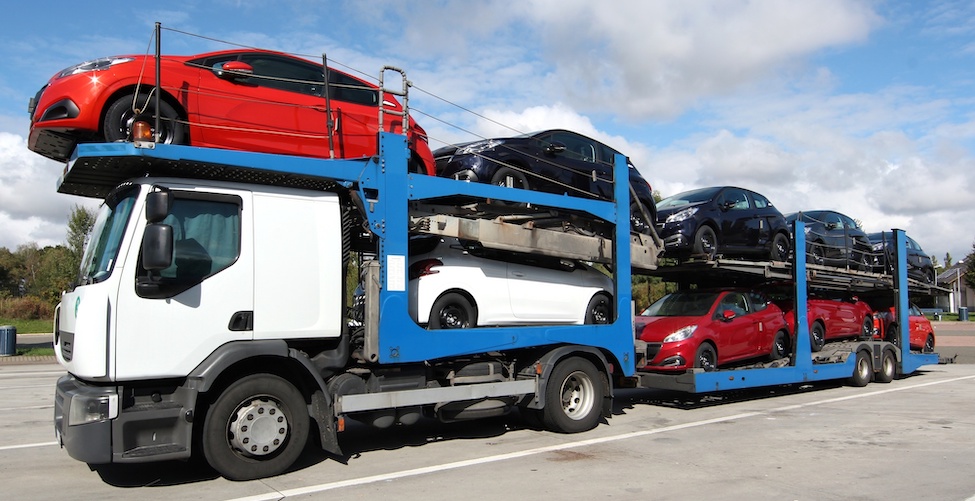The Essential Local Moving Checklist

Local Moving Checklist
Did you know that around 40 million Americans move to a new home each year? Whether it’s cross country or just around the corner, Americans move far more than their European counterparts.
Thankfully, the local moving cost is lower and the process more straightforward than a long-distance move. There’s less paperwork, you don’t have to arrange vehicle transportation, and all your personal items arrive the day you move. But that said, if you procrastinate, you’ll be in for a stressful time.
The key is getting organized. Follow our local moving checklist and you’ll be ready for a low-stress move day.
We’ve broken the checklist down into sections. The first part starts 6 weeks ahead of your move. If that sounds like a long time in advance, trust us, you’ll thank us later.

Man and Woman Unpacking Near Our First Home Welcome Mat, Moving Boxes and Plant.
6 Weeks Before Moving Day
It’s time to go through all your closets, storage rooms, and the basement. Sort through all your belongings and separate them into items to keep and items to discard. Decide whether you will donate the items to goodwill or try to sell them.
Next, go through the rest of the house room by room. Declutter your home as much as possible. Don’t pay to move things that you’re never going to use again.
If you have items to sell, you’ll get a better price on Craigslist or eBay than at a garage sale. Enlist the help of your kids to get as many items listed as possible at this time.
Now is the time to set a moving budget and find movers. Get at least three quotes from local moving companies.
Some moving companies can supply boxes, tape, bubble wrap, etc. If not, now’s the time to buy these supplies online and have them delivered in the next week or so.
It’s time to think about schools. If you’re moving out of the school district, your children will have to move. Apply now for the new school and arrange to transfer their records.
4 Weeks Before Moving Day
You’ve got your quotes, now it’s time to confirm your movers before they get booked up. If you would like help with packing, now is the time to make those arrangements.
It’s also time to prepare the home to hand over to the next tenant or owner. Review your lease and make sure that you fulfill all of your responsibilities. Start putting together some helpful tips for the new tenant or owner.
Gather your important documents in a safe place. You can arrange to terminate your building’s insurance on the day of your move and set up insurance for your new home.
Also, take a quick inventory of all your valuables and gather them together. It might be a good idea to move those items yourself on moving day, or leave them with family for safekeeping ahead of your move.
Now that your moving boxes have arrived, plan how you will organize them. Will you write the contents on each box? Will you number them and write the contents in a notebook or on a spreadsheet?
You can now start to pack infrequently used items. Let the kids help with packing old toys or clothes that are out of season.
If you didn’t manage to sell everything, consider holding a garage sale.
Take a look in your pantry, refrigerator, and freezer. Make a meal plan for the next few weeks that will allow you to use up all your supplies. Why pay to transport them to your new home?
2 Weeks Before Moving Day
It’s now time to let the utility company know that you’re moving. Arrange with the next company so that the transition is seamless. It’s also a good time to apply for parking permits for your new home if needed.
On moving day, you should have an essentials box. This could contain silverware, plates, mugs, coffee, and any other essentials you’ll need as soon as you move in. Make a plan, make up a box, and start to assemble what you need.
You don’t want your kids and pets underfoot and stressed out on moving day. Arrange someone to care for both of them on the day.
1 Week Before Moving Day
The heat is on – now you should be coming close to finishing your packing. All non-essentials can be packed at this stage, leaving out just the clothes and toiletries that you will need for your last week.
Work your way through the house, cleaning room by room.
File your change of address with USPS so that you don’t miss any important mail.
Moving Day
If you follow these local moving tips, moving day will be a breeze!
All you will have to do is supervise your movers. Help them out by clearly communicating where you want everything to go in your new home. Don’t forget to keep some cash on hand to tip them if they do a good job.
Finally, do one last inspection of your old home. Leave the instructions for the new residents and lock the door for the final time.
In your new home, bust out the essentials box. Order takeout, and enjoy your first evening in your new home.
How Much do Movers Cost for a Local Move?
Local moving costs will vary depending on how far you are moving and how many movers you hire. Usually, the number of movers doesn’t impact the cost too much. Hiring more movers means a shorter move time, so it tends to even out.
The average local move costs around $1,250. This is for a two-person moving team for a move of fewer than 100 miles. A mover’s average cost will be around $50-100 per hour, per person.
There may be additional charges for moving truck rental and gas as well.
Follow Our Moving Tips and Checklists for Success
Moving can be stressful, but our moving tips and checklists can simplify it as much as possible.
You can’t put a price on peace of mind! Follow the local moving checklist and don’t leave jobs until the last minute. Your hard work will all pay off when you’re ready to enjoy your new home from day one.
When it’s time to move, call the best local movers near me. Fleet53 has years of experience in full-service local moves across the country. We have locations in Los Angeles; Dallas, TX; Marietta, GA; and Chicago.
Call us at 219-247-7186. Alternatively, contact us for a moving quote online today!
Related Articles
General
How To Ship A Car

Finding the Best Way For Shipping Your Car All of these cars and no one to drive them. How will you possibly move them from place to place? By shipping them! What you might be wondering, however, is how do you ship a car? What steps must you follow in order to do it right? There is […]
Read MoreGeneral
How Much Does a Moving Company Cost?

How Much Does a Moving Company Cost? The cost for a moving company can vary widely based on several different factors, which we will examine below. So you’ve decided to pull the trigger and move residences. Did you know that Americans move an average of 11.7 times in their life? If you’re a first-time mover, you’re in for […]
Read More